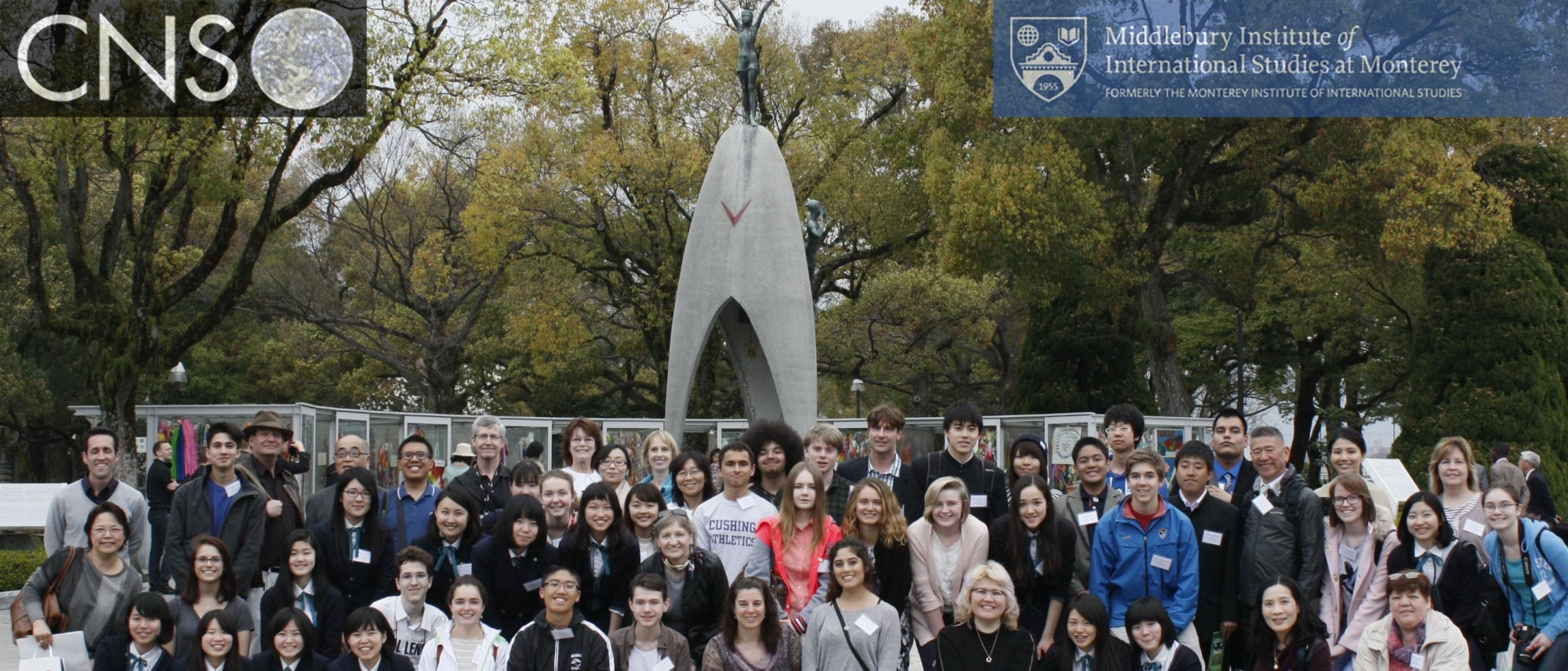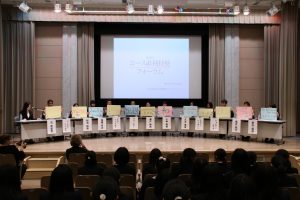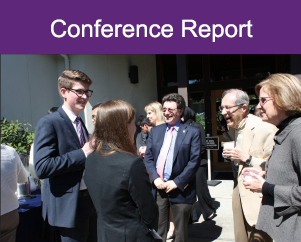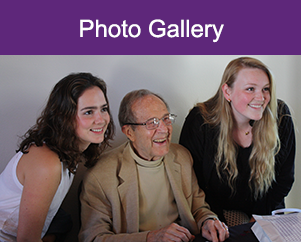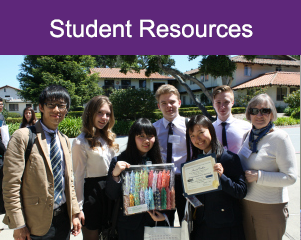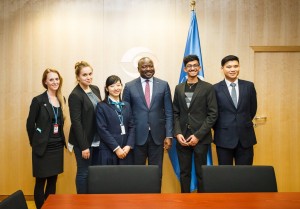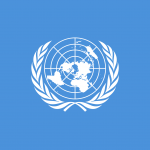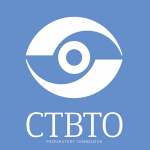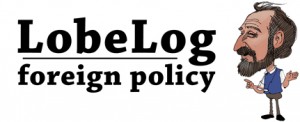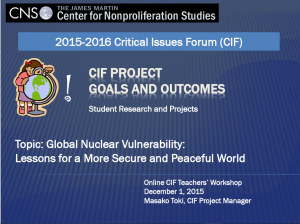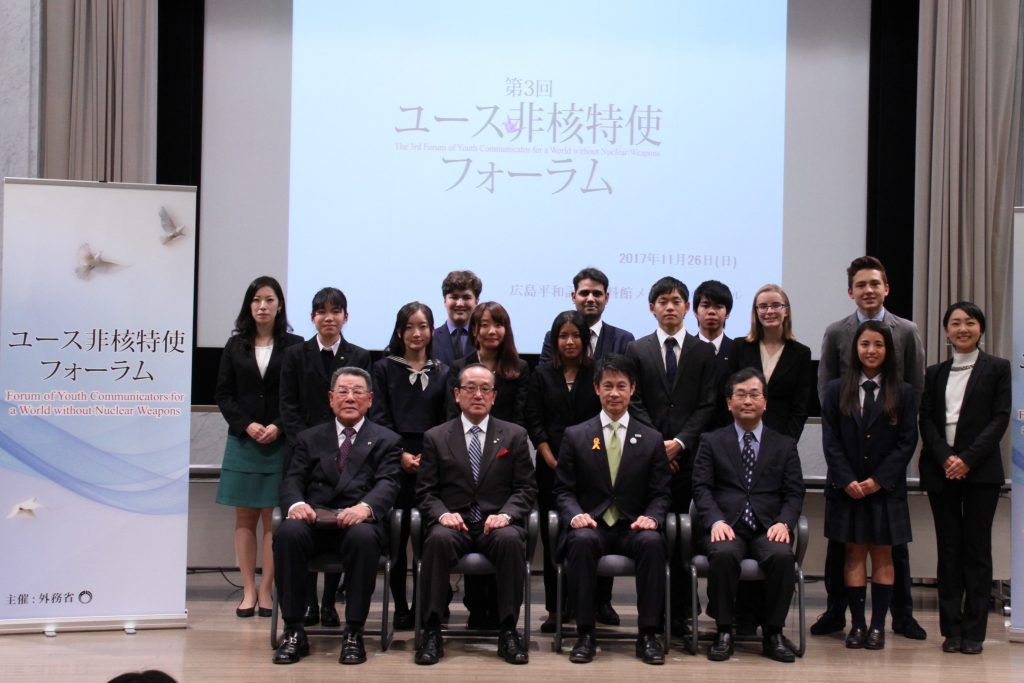
Critical Issues Forum (CIF) students participated in the 3rd Forum for Youth Communicators for a World without Nuclear Weapons in Hiroshima
By Masako Toki*
For the second year in a row, four students from the Critical Issues Forum (CIF) were invited to present their work at the Forum of Youth Communicators for a World without Nuclear Weapons organized by the Japanese Ministry of Foreign Affairs (MOFA) on November 26, 2017.
Brimming with the youth communicators’ enthusiasm, creativity, and determination, the Forum kicked off a week of many high-level nuclear-disarmament-related meetings in Hiroshima, including the Group of Eminent Persons for Substantive Advancement of Nuclear Disarmament convened by MOFA on November 27 and 28, and the 27th United Nations Conference on Disarmament Issues (UNCDI) in Hiroshima, on November 29 and 30. The UN Conference was organized by the UN Regional Centre for Peace and Disarmament in Asia and the Pacific with a cooperation with MOFA, Hiroshima Prefecture, and the City of Hiroshima.
In Hiroshima, people’s excitement for disarmament received a major boost when this year’s Nobel Peace Prize was awarded to the International Campaign to Abolish Nuclear Weapons (ICAN), which has closely worked with hibakusha (atomic bomb survivors) toward the adoption of the Nuclear Weapons Ban Treaty in July earlier this year
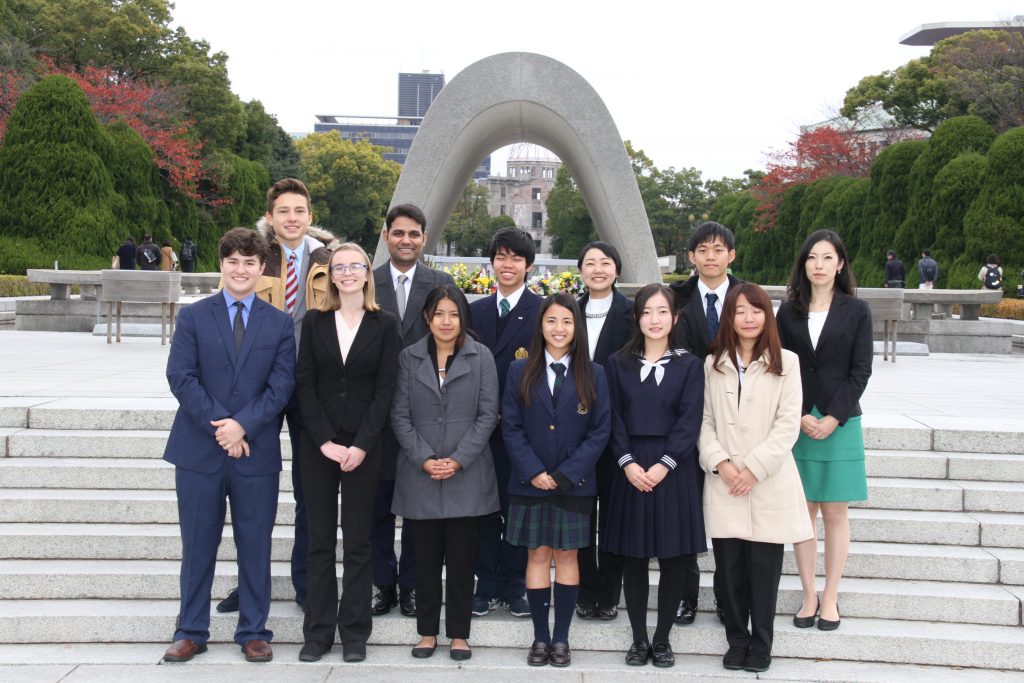
Youth Communicators in front of Cenotaph for A-bomb victims at the Hiroshima Peace Park
The selected students represented schools in two states in the United States and one school in Russia’s closed nuclear city: Sarah Bitter from Pacific Grove High School (Pacific Grove, CA), Jonathan Muraki from Rock University High School (Janesville, Wisconsin), Lesly Tobon from Dr. Olga Mohan High School (Los Angeles, CA), and Makar Fedorov from Gimnasia #41 (Novouralsk, Russia).
The Critical Issues Forum (CIF) is an international disarmament and nonproliferation education project where high school students interested in important global issues of nuclear weapons can develop their critical thinking and professional presentation skills, while promoting awareness of current topics within the field. The highlight of the CIF project is the spring students conference where they can present their semester-long studies, and meet with participants from other countries, and learn from world leaders and scholars. The report showcasing their work at the 2017 conference may be found here.
CIF students who participated in the Spring conference in April 2017 in Nagasaki were designated as Youth Communicators by the Japanese Foreign Ministry. In 2016, the Japanese MOFA expanded the Youth Communicators program to non-Japanese youths. CIF US and Russian students are the first ones to assume such a distinguished title. The Youth Communicators initiative was launched by then-Foreign Minister Fumio Kishida in 2013. Three years later, at the G7 Foreign Ministers meeting in Hiroshima in 2016, Mr. Kishida again launched a new initiative to expand the Youth Communicators program globally, as a way for young generations around the world to learn the importance of nuclear disarmament based on the actual impacts of the use of nuclear weapons in Hiroshima and Nagasaki.
On Sunday morning, the Youth Communicators participated in a flower ceremony at the Cenotaph for the A-Bomb Victims in the Hiroshima Peace Memorial Park to lay a wreath at the monument to respect and honor the memory of those who lost their lives in the atomic bombing.
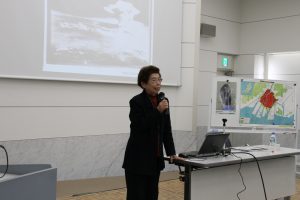
Sadae Kasaoka, Hibakusha, sharing her experience with the Youth Communicators
As one of the most important pre-forum activities, students had the unique opportunity to hear hibakusha Sadae Kasaoka share her experiences surviving the bomb in Hiroshima as a young girl, and visit the Atomic Bomb Museum where they witnessed the horrifying realities of nuclear weapon use. Students learned the impact of the use of a nuclear weapon through such activities.
At the official session of the Youth Forum, opening and welcome remarks highlighted the importance of educating the younger generation about the realities of nuclear weapons use and issues of nuclear disarmament and nonproliferation.
Ambassador Tomonori Yoshida, Director-General of Disarmament, Non-Proliferation and Science Department, Ministry of Foreign Affairs; Mr. Hidehiko Yuzaki, Governor of Hiroshima Prefecture; Mr. Kazumi Matsui, Mayor of Hiroshima City warmly welcomed these future leaders. Additionally, Mr. Minoru Hasebe, a former professional baseball player for Hiroshima Toyo Carp—which is so dear to people in Hiroshima—shared his experience playing with the treasured team and providing inspiration as the city rose from the ashes of the atomic bomb. He also expressed his hope that young generations around the world work for nuclear disarmament together.
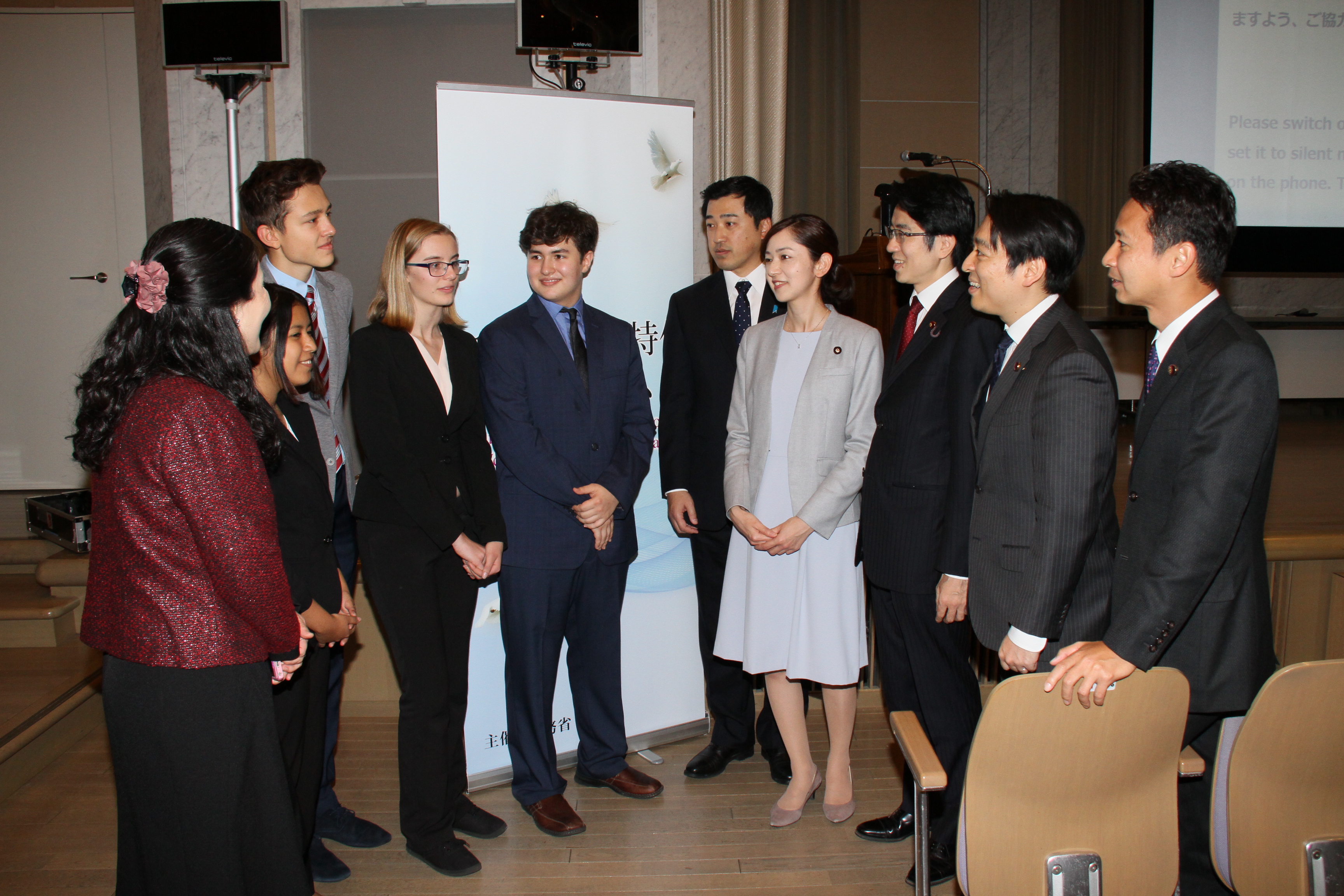
CIF students from the US and Russia talking with Japanese National Diet Members
In addition, five National Diet (Japanese Parliament) Members who are active in nuclear disarmament, as well as several members of the Hiroshima Municipal Assembly attended the Forum as observers. Prior to the Forum, the CIF students had an opportunity to briefly exchange their views on nuclear disarmament with these National Diet Members.
The highlight of the Forum was each group of Youth Communicators’ presentations. In addition to the CIF team, there were four different groups of Youth Communicators. Each group introduced their project activities. The CIF team explained the goals and purpose of the CIF project, this year’s spring conference in Nagasaki, and each school’s post-conference follow-up activities.

CIF students presentat at the Youth Communicators Forum
Following the students presentations, Dr. Wakana Mukai moderated two separate panel discussions, in which students tackled questions about their own countries’ nuclear weapon policies, how they became involved in the Youth Communicators, and what they want to communicate to future generations about nuclear nonproliferation and disarmament.
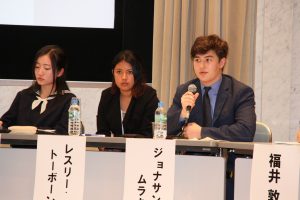
Jonathan Muraki, CIF Alum during the panel discussion
Almost all the Japanese students criticized Japan’s nuclear disarmament policy because the government does not support the Treaty on the Prohibition of Nuclear Weapons. CIF US students also condemned US nuclear weapon modernization plans and the lack of progress toward nuclear disarmament. The Russian student introduced post-Cold War nuclear cooperation to reduce nuclear dangers between the US and Russia, such as “Megatons to Megawatts” program.
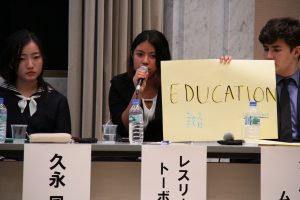
Lesly Tobon, CIF Alum shares her one word message: Education.
Dr. Mukai concluded the official forum by having each of the students share his or her one-word message for how to achieve a world without nuclear weapons. Messages included words such as education and believe.
Following the official Forum, participants were invited to the welcome reception hosted by Japanese Parliamentary Vice-Minister for Foreign Affairs Mitsunari Okamoto.
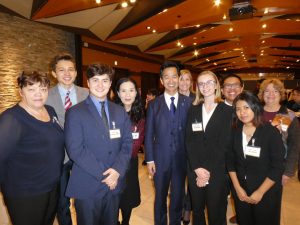
CIF team and Mr. Okamoto at the Reception
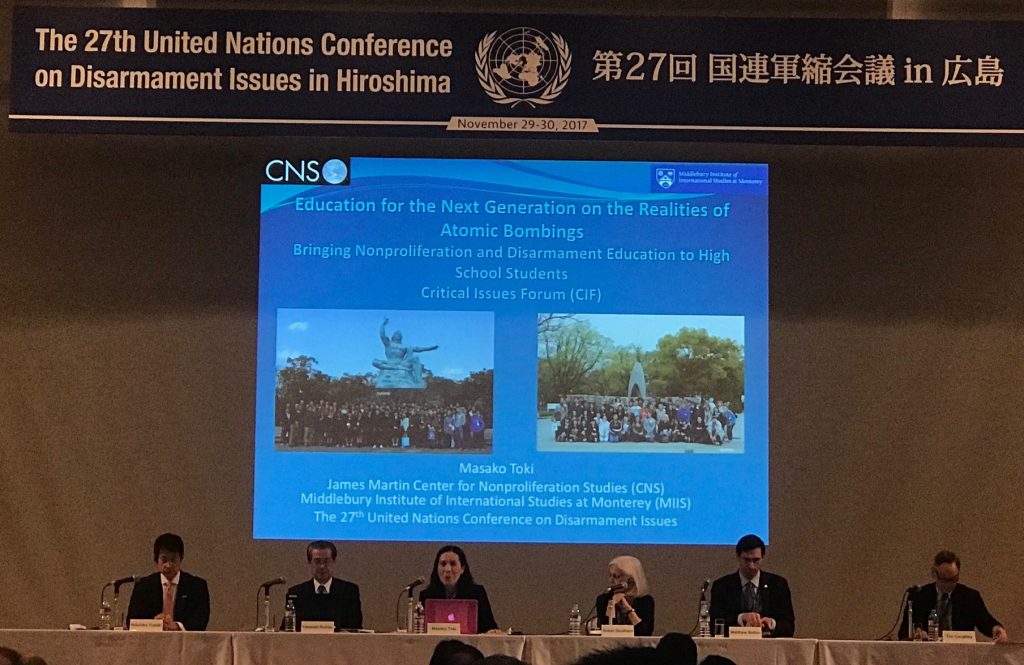
UN Disarmament Conference Session 2: Education for the Next Generation on the Realities of the Atomic Bombings
On November 29 and 30, the CIF students had an opportunity to observe the 27th United Nations Conference on Disarmament Issues. CIF Project Manager Masako Toki served as a panelist at one of the sessions titled, “Education for the Next Generation on the Realities of the Atomic Bombing” where she presented the importance of disarmament and nonproliferation education for high school students around the world using the example of the Critical Issues Forum.
Throughout all activities, the CIF students professionally represented their schools, the CIF, and their countries. Once again, the opportunity to speak at such a prestigious conference represented a momentous event in the students’ lives, and the memories and experiences will shape their efforts to work towards nuclear disarmament in the years ahead.
The 2018 CIF project will focus on the Treaty on the Prohibition of Nuclear Weapons (TPNW), a new and challenging topic that will require students understand the humanitarian aspects of nuclear weapons. Students’ experiences in Hiroshima will undoubtedly bolster their efforts to comprehensively tackle this important new subject.
In the spring, CIF will bring Japanese, Russian, and US students and teachers to Monterey to discuss the TPNW and challenges facing it, and how to achieve a nuclear-weapon free world.
The CIF project is sponsored by the United States and Japan Foundation, and the Tom and Sarah Pattison Fund.
*Many portions of this report were contributed by Ms. Karinne Gordon, teacher at Pacific Grove High School who chaperoned CIF students to the Forum in Hiroshima
Photo Credits: Ministry of Foreign Affairs of Japan, and Karinne Gordon, Pacific Grove High School
Don’t forget to check out the report of US and Russian CIF students at the 2016 Nagasaki Youth Forum
